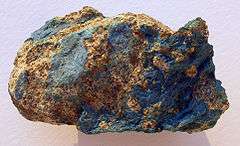Aerinite
| Aerinite | |
|---|---|
|
Aerinite from Spain | |
| General | |
| Category | Inosilicate |
| Formula (repeating unit) | Ca4(Al,Fe,Mg)10Si12O35(OH)12CO3·12H2O |
| Strunz classification | 9.DB.45 |
| Crystal system |
Monoclinic Unknown space group |
| Unit cell |
a = 14.690(15), b = 16.872(15) c = 5.170(15) [Å]; β = 94.75°; Z = 1[1] |
| Identification | |
| Color | Blue to blue-green |
| Crystal habit | fibrous |
| Mohs scale hardness | 3 |
| Luster | vitreous |
| Streak | bluish white |
| Diaphaneity | translucent |
| Specific gravity | 2.48 |
| Optical properties | Biaxial (-) |
| Refractive index | nα1.510(5), nβ = 1.560(5), nγ = 1.580 |
| Pleochroism | Intense; X = bright blue; Y = Z = pale beige |
| 2V angle | 63° (calc.) |
| Dispersion | δ = 0.07 |
| References | [2][3][1] |

Aerinite from Spain
Aerinite (Ca4(Al,Fe,Mg)10Si12O35(OH)12CO3·12H2O) is a bluish-purple inosilicate mineral. It crystallizes in the monoclinic system and occurs as fibrous masses and coatings. It has a dark, vitreous luster, a specific gravity of 2.48 and a Mohs hardness of 3.
It is a low-temperature hydrothermal phase occurring in zeolite facies alteration of mafic rocks. Associated minerals include prehnite, scolecite and mesolite.[2]
Its name comes from a Greek root "aerinos," meaning "atmosphere" or "sky".[1]
References
This article is issued from Wikipedia - version of the 8/23/2016. The text is available under the Creative Commons Attribution/Share Alike but additional terms may apply for the media files.
